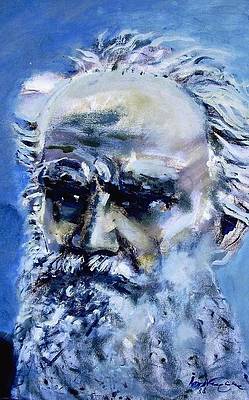Leo Tolstoy Archive
Written: 1904
Source: "Fables for Children," by Leo Tolstoy, translated from the original Russian and edited by leo Wiener, assistant Professor of Slavic Languages at Harvard University, published by Dana Estese Company, Boston, Edition De Luxe, limited to one thousand copies of which this is no. 411, copyright 1904, electrotyped and printed by C. H. Simonds and Co., Boston, Massachusetts, USA.
Transcription/Markup: Andy Carloff
Online Source: RevoltLib.com; 2021

A gray hare was living in the winter near the village. When night came, he pricked one ear and listened; then he pricked his second ear, moved his whiskers, sniffed, and sat down on his hind legs. Then he took a leap or two over the deep snow, and again sat down on his hind legs, and looked around him. Nothing could be seen but snow. The snow lay in waves and glistened like sugar. Over the hare's head hovered a frost vapor, and through this vapor could be seen the large, bright stars.
The hare had to cross the highway, in order to come to a threshing-floor he knew of. On the highway the runners could be heard squeaking, and the horses snorting, and seats creaking in the sleighs.
The hare again stopped near the road. Peasants were walking beside the sleighs, and the collars of their caftans were raised. Their faces were scarcely visible. Their beards, mustaches, and eyelashes were white. Steam rose from their mouths and noses. Their horses were sweaty, and the hoarfrost clung to the sweat. The horses jostled under their arches, and dived in and out of snow-drifts. The peasants ran behind the horses and in front of them, and beat them with their whips. Two peasants walked beside each other, and one of them told the other how a horse of his had once been stolen.
When the carts passed by, the hare leaped across the road and softly made for the threshing-floor. A dog saw the hare from a cart. He began to bark and darted after the hare. The hare leaped toward the threshing-floor over the snow-drifts, which held him back; but the dog stuck fast in the snow after the tenth leap, and stopped. Then the hare, too, stopped and sat up on his hind legs, and then softly went on to the threshing-floor.
On his way he met two other hares on the sowed winter field. They were feeding and playing. The hare played awhile with his companions, dug away the frosty snow with them, ate the wintergreen, and went on.
In the village everything was quiet; the fires were out. All one could hear was a baby's cry in a hut and the crackling of the frost in the logs of the cabins. The hare went to the threshing-floor, and there found some companions. He played awhile with them on the cleared floor, ate some oats from the open granary, climbed on the kiln over the snow-covered roof, and across the wicker fence started back to his ravine.
The dawn was glimmering in the east; the stars grew less, and the frost vapors rose more densely from the earth. In the near-by village the women got up, and went to fetch water; the peasants brought the feed from the barn; the children shouted and cried. There were still more carts going down the road, and the peasants talked aloud to each other.
The hare leaped across the road, went up to his old lair, picked out a high place, dug away the snow, lay with his back in his new lair, dropped his ears on his back, and fell asleep with open eyes.